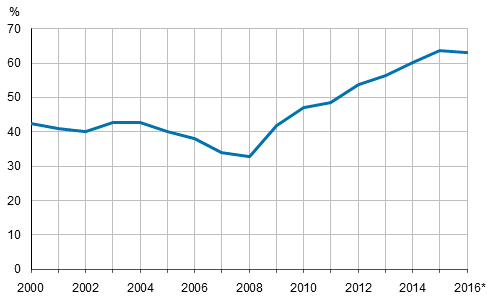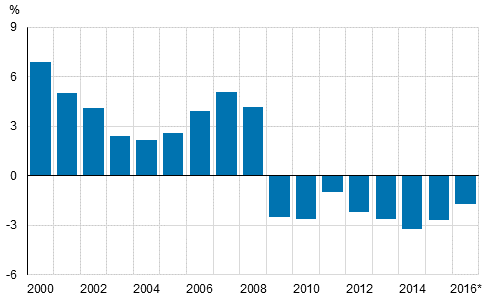Published: 23 October 2017
General government deficit for 2016 was revised by EUR six million
General government deficit for 2016 decreased by EUR six million during Eurostat’s verification period compared with the figure published at the end of September. According to revised data, general government deficit for 2016 was EUR 3,769 million (was EUR 3,775 million) and 1.7 per cent relative to gross domestic product (was 1.8 per cent). The revisions were directed to central government. General government debt did not change during the verification period. General government debt was 63.1 per cent relative to gross domestic product at the end of 2016.
General government EDP debt relative to GDP

Consolidated general government gross debt (EDP debt) amounted to EUR 136.0 billion at the end of 2016. The debt grew by EUR 2.8 billion in 2016. Compared to the preliminary data released in March, the ratio of debt to GDP was now updated 0.5 percentage points lower, and was thus 63.1 per cent in 2016. The change was almost entirely caused by the revision of GDP. At the end of 2015, the GDP share of the EDP debt was 63.6 per cent. The EDP debt describes general government’s debt to the other sectors of the economy and to the rest of the world, and its development is influenced by changes in both the unconsolidated gross debt and the internal general government debt.
General government EDP deficit (-) relative to GDP

In 2016, general government deficit, or net borrowing according to national accounts, was EUR 3.8 billion. The financial position improved by EUR 1.9 billion from the previous year. Compared to the preliminary data released in March, the deficit for 2016 diminished by EUR 331 million. Of general government subsectors, the biggest updates concerned local government where deficit decreased compared to March by EUR 175 million to EUR 864 million. The updating of data was due to revised source data.
About the content and concepts of the statistics
General government surplus/deficit refers to net lending/borrowing according to the sector accounts of national accounts, which is the difference between the total revenue and expenditure. For instance, in the case of local government, the concept differs from the surplus/deficit of the accounting period according to the profit and loss accounts of municipalities and joint municipal authorities included in the sector. The key difference concerns investments, which are recorded in national accounts as expenditure as such.
In general government accounts, the European Financial Stability Facility EFSF is, based on Eurostat's decision, handled so that the EFSF's borrowing is recorded as part of the gross government debt of the countries that have provided guarantees. The loan received by the beneficiary country from the EFSF is recorded as if it had been received from the countries in the euro area that have provided guarantees and these countries in turn owe the corresponding amount to the EFSF. As a result, the EDP gross debt of the countries that provided guarantees grows but the net debt remains unchanged because the countries have a similar receivable from the beneficiary country. The gross government debt to be recorded for each country on the loans granted by the EFSF is calculated by dividing the loan granted to the beneficiary country by the contribution key (based on the share in the ECB's capital of each country participating in the support operations).
At the end of 2016, Finland's general government debt includes EUR 3,401 million of debt granted by the EFSF to beneficiary countries. At the end of 2015, the amount was the same. Corresponding treatment does not apply to the European Stability Mechanism (ESM).
Central government's EDP debt differs as a concept from the central government debt published by the State Treasury. Central government's EDP debt includes loans granted to beneficiary counties by the European Financial Stability Facility EFSF, received cash collateral related to derivative contracts, the capital of the Nuclear Waste Management Fund, debts generated from investments in central government's PPP (public-private partnership) projects, and coins that are in circulation. In national accounts, central government is also a broader concept than the budget and financial economy, in addition to which it includes, for example, universities, Solidium, the Finnish Broadcasting Company and Senate Properties. When these differences are taken into consideration, we reach the central government non-consolidated gross debt in accordance with the EDP concept (Appendix table 2). In 2016, the State Treasury's central government debt EUR 102.4 billion + conceptual differences of the debt EUR 10.1 billion + differences caused by the sector delimitation EUR 3.2 billion = central government gross debt EUR 115.7 billion. The valuation principle for both debt concepts is the nominal value, where the effect of interest-rate contracts and currency swaps is taken into account.
A list of units belonging to general government (only in
Finnish) can be found at http://www.stat.fi/meta/luokitukset/_linkki/julkisyhteisot.html
.
Decisions on major sector classification cases (only in Finnish)
are available at http://www.stat.fi/meta/luokitukset/_linkki/soveltamisp.html
.
Source: General government deficit and debt. Statistics Finland
Inquiries: Niina Suutarinen 029 551 2307, Atte Virtanen 029 551 3685, financial.accounts@stat.fi
Director in charge: Ville Vertanen
Publication in pdf-format (239.3 kB)
- Tables
-
Tables in databases
Pick the data you need into tables, view the data as graphs, or download the data for your use.
Appendix tables
- Figures
- Revisions in these statistics
-
- Revisions in these statistics (23.10.2017)
Updated 23.10.2017
Official Statistics of Finland (OSF):
General government deficit and debt [e-publication].
ISSN=1799-5914. 2016. Helsinki: Statistics Finland [referred: 18.12.2025].
Access method: http://stat.fi/til/jali/2016/jali_2016_2017-10-23_tie_001_en.html

